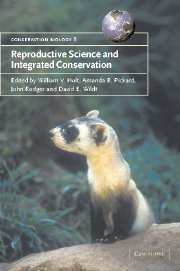Book contents
- Frontmatter
- Contents
- List of contributors
- Foreword
- Part I Introduction
- Part II Reproduction and population viability
- Part III Reproductive techniques for conservation management
- Part IV Integrated conservation management
- 14 Integrating reproductive sciences into recovery programmes for declining and extinct marsupial populations
- 15 Captive breeding and predator control: a successful strategy for conservation in Western Australia
- 16 Black-footed ferret: model for assisted reproductive technologies contributing to in situ conservation
- 17 Genetic resource banks for species conservation
- 18 Fertility control for wildlife
- 19 Contraceptive vaccine development
- 20 Field applications of fertility control for wildlife management
- Part V Reproduction science in non-mammalian species
- Part VI Conclusions
- Index
- References
16 - Black-footed ferret: model for assisted reproductive technologies contributing to in situ conservation
Published online by Cambridge University Press: 21 January 2010
- Frontmatter
- Contents
- List of contributors
- Foreword
- Part I Introduction
- Part II Reproduction and population viability
- Part III Reproductive techniques for conservation management
- Part IV Integrated conservation management
- 14 Integrating reproductive sciences into recovery programmes for declining and extinct marsupial populations
- 15 Captive breeding and predator control: a successful strategy for conservation in Western Australia
- 16 Black-footed ferret: model for assisted reproductive technologies contributing to in situ conservation
- 17 Genetic resource banks for species conservation
- 18 Fertility control for wildlife
- 19 Contraceptive vaccine development
- 20 Field applications of fertility control for wildlife management
- Part V Reproduction science in non-mammalian species
- Part VI Conclusions
- Index
- References
Summary
INTRODUCTION AND OBJECTIVES
Assisted reproductive technologies (artificial insemination [AI], in vitro fertilisation [IVF], embryo transfer and gamete/embryo cryopreservation) have been postulated for decades as ‘high-tech’ solutions for helping conserve genetics and biodiversity. There is no doubt that these techniques could offer many advantages for managing small populations, largely by ensuring that all genetically valuable animals reproduce (Howard, 1993, 1999; Wildt & Roth, 1997; Wildt et al., 1997). The potential of assisted reproduction could be enhanced further by developing genome resource banks (repositories of cryopreserved sperm, eggs, embryos), thus preserving valuable genetic material for future generations. The combined use of assisted breeding and germplasm banks also has potential for infusing genetic material from wild-born individuals into genetically stagnant ex situ populations or even exchanging genetic material between isolated wild populations (Holt et al., 1996; Wildt et al., 1997).
Despite these advantages, assisted reproduction has not been used consistently in ‘practical’ wildlife management and in situ conservation, largely for one reason: until recently, no wildlife species has been adequately studied, at least to the extent that its reproduction was so comprehensively understood that assisted breeding could become routine.
It commonly is assumed that reproductive knowledge and techniques well established for laboratory rodents, domestic farm species and even humans are readily adaptable to propagating or overcoming infertility in wild animals (Wildt et al., 2000). This is a misperception because all species have naturally evolved ‘species-specific’ reproductive mechanisms, most of which have not yet been elucidated.
- Type
- Chapter
- Information
- Reproductive Science and Integrated Conservation , pp. 249 - 266Publisher: Cambridge University PressPrint publication year: 2002
References
- 2
- Cited by

